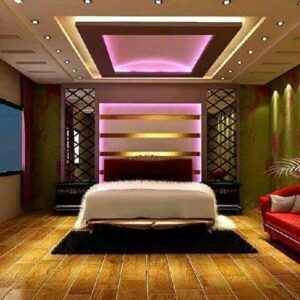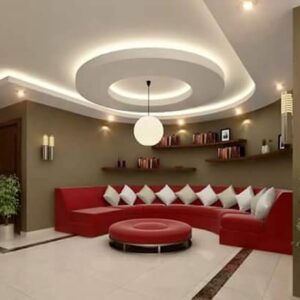Interior Design Trends for Stylish Homes
In 2024, interior design trends continue to evolve, bringing fresh and innovative ideas that enhance the aesthetic appeal and functionality of homes. Whether you’re revamping your space or just looking for inspiration, these trends will help you create a stylish, modern home that reflects your personality and taste. From sustainable materials to bold colors, here are some of the top interior design trends for 2024 that will elevate your living spaces.
1. Sustainable and Eco-friendly Materials
Sustainability is more than just a trend; it’s become a way of life for homeowners and designers alike. Eco-friendly materials are not only good for the planet but also create beautiful, timeless interiors.
- Natural Materials: Expect to see an increase in the use of organic materials like wood, stone, and bamboo. These materials are timeless, durable, and provide a warm, earthy feel to any room.
- Recycled Materials: Recycled glass, reclaimed wood, and repurposed metals are becoming more popular, offering both environmental benefits and unique character.
- Non-toxic Paints and Fabrics: As awareness grows about harmful chemicals, there’s a shift toward non-toxic paints, fabrics, and finishes, ensuring that your home is both stylish and safe.
Why it’s trending:
People are becoming more mindful of their environmental impact. Sustainable interior design offers a chance to create beautiful homes that reflect personal values and contribute to the health of the planet.
2. Biophilic Design – Bringing the Outdoors In
Biophilic design, which focuses on connecting indoor spaces with nature, continues to gain momentum in 2024. It’s about integrating natural elements like plants, natural light, and water features into the interior of your home.
- Indoor Plants: Large indoor plants like ferns, palms, and monstera add life and vibrancy to interiors. They not only purify the air but also create a calming atmosphere.
- Natural Light: Maximizing natural light through large windows or glass doors is a key aspect of biophilic design. The connection between the indoors and outdoors is central to this trend.
- Water Features: Small indoor fountains or water walls are becoming popular for their soothing sounds and aesthetic appeal.
Why it’s trending:
Biophilic design is believed to reduce stress, improve mood, and increase overall well-being. In a world where we spend most of our time indoors, connecting with nature can provide a much-needed sense of tranquility.
3. Maximalism – Embrace Bold Colors and Patterns
While minimalist design has had its time in the spotlight, maximalism is now making a comeback. This trend is all about embracing bold colors, patterns, and textures to create an energetic and vibrant space.
- Bold Color Palettes: Expect to see bright jewel tones like emerald green, deep blues, and rich purples. These colors are being paired with contrasting hues for a more dynamic look.
- Pattern Mixing: Maximalist design encourages the use of eclectic patterns. Combining florals with stripes, geometric prints with animal prints, and bold textures creates a unique, personalized space.
- Statement Furniture and Accessories: From oversized art pieces to quirky furniture designs, maximalism is all about making a statement with your decor choices.
Why it’s trending:
Maximalism allows people to express their individuality and create spaces that are full of personality. It encourages creativity and playfulness, offering a way to break away from the neutrality of minimalism.
4. Multifunctional and Flexible Spaces
As our homes become more versatile to accommodate work, relaxation, and family life, multifunctional spaces are gaining popularity. The key is to design rooms that can easily adapt to different needs.
- Foldable and Modular Furniture: Furniture that can be folded, expanded, or rearranged is increasingly in demand. This allows rooms to serve multiple purposes, such as a guest room doubling as an office.
- Open Concept Living: Open floor plans continue to dominate, but with the addition of movable partitions, curtains, or room dividers to create flexible spaces.
- Storage Solutions: Smart storage is a must. Custom-built cabinets, shelving units, and hidden storage options keep the space organized and functional.
Why it’s trending:
As lifestyles become more fluid and dynamic, the need for flexible and adaptable living spaces has increased. Multifunctional rooms ensure that every square foot is utilized efficiently.
5. Vintage and Retro Designs
Nostalgia is a strong force in interior design, with retro and vintage designs making a significant comeback in 2024. From mid-century modern to 70s-inspired decor, incorporating elements from the past can give your home a timeless, eclectic feel.
- Retro Furniture: Bold furniture designs like curved sofas, geometric chairs, and statement coffee tables are popping up in living rooms and lounges.
- Vintage Lighting Fixtures: Look for vintage-style lighting, like pendant lamps, art deco chandeliers, and table lamps with a retro aesthetic.
- Colorful Accents: Earthy tones like mustard yellow, burnt orange, and avocado green, which were popular in the 70s, are making a return.
Why it’s trending:
Vintage and retro designs bring a sense of warmth and character to modern spaces. These pieces often tell a story and evoke memories, adding an emotional connection to the home.
6. Dark and Moody Interiors
In contrast to the light and airy interiors that have been popular in recent years, 2024 sees a rise in dark and moody interiors. Deep, rich colors create dramatic, cozy environments that feel intimate and inviting.
- Deep Hues: Dark tones like charcoal gray, navy blue, forest green, and rich burgundy are being used on walls, furniture, and accessories.
- Moody Lighting: Lighting plays a crucial role in dark interiors. Low lighting fixtures, warm LED lights, and dimmers help create a cozy ambiance without making the room feel too dark.
- Velvet and Leather Textures: Luxurious textures like velvet sofas, leather chairs, and plush rugs add depth and sophistication to dark interiors.
Why it’s trending:
Dark and moody interiors create a sense of drama and intimacy, perfect for creating cozy spaces like bedrooms and lounges. This trend is perfect for those who love a more dramatic and personalized aesthetic.
7. Technology Integration – Smart Homes
As technology continues to play a larger role in daily life, smart home designs are becoming more common. Integrating technology seamlessly into interior design is essential for 2024 homes.
- Smart Lighting and Thermostats: LED smart bulbs, motion-sensing lights, and voice-activated thermostats offer convenience and efficiency while enhancing your home’s modern look.
- Smart Furniture: Furniture pieces like desks with built-in charging ports or couches with integrated Bluetooth speakers are becoming essential in smart homes.
- Voice-Controlled Devices: Alexa, Google Home, and other smart devices are being integrated into home decor, making it easier to control everything from lighting to security.
Why it’s trending:
Smart home technology improves comfort, efficiency, and convenience, making it easier for homeowners to manage their homes. It also adds a futuristic and sleek touch to any space.
8. Art Deco Revival
Art Deco, the glamorous and opulent design style of the 1920s and 1930s, is making a strong comeback in 2024. Its bold geometric shapes, rich colors, and luxurious materials are perfect for adding a touch of sophistication to any home.
- Geometric Patterns: Look for sharp, angular patterns on rugs, wallpaper, and furniture.
- Metallic Finishes: Gold, chrome, and brass finishes are common in Art Deco interiors, often used on furniture, lighting, and decor.
- Luxurious Materials: Velvet, lacquered wood, marble, and glass are frequently used in Art Deco-inspired spaces to create a sense of opulence.
Why it’s trending:
Art Deco is perfect for those looking to add a touch of elegance and glamour to their home. Its timeless style is highly adaptable to both modern and traditional spaces.
9. Personalized Spaces
Personalization is key to making your home feel unique and reflective of your personality. In 2024, expect to see more spaces that are tailored to the individual tastes and lifestyles of the homeowners.
- Custom Furniture and Decor: Tailored furniture pieces, custom-made artwork, and personal touches like family heirlooms or travel souvenirs are becoming popular.
- Eclectic Mix: Combining various design styles, colors, and textures that reflect your personality and history adds warmth and character to any room.
- DIY Projects: Homeowners are increasingly taking on DIY projects, whether it’s crafting their own furniture, painting a feature wall, or creating unique wall art.
Why it’s trending:
Personalized spaces make a home feel truly unique and comfortable. It’s a way to express yourself and create an environment that’s all your own.
Conclusion
The interior design trends for 2024 are all about blending style with functionality, sustainability, and personal expression. From biophilic design to bold maximalism, these trends offer something for every taste and lifestyle. Whether you’re looking to refresh a single room or undertake a complete home makeover, these trends will help you create a stylish, modern home that’s both beautiful and functional.


